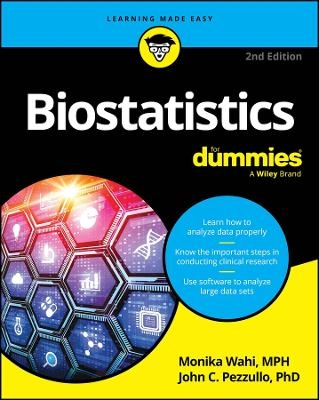
Biostatistics For Dummies
For Dummies (Verlag)
978-1-394-25146-9 (ISBN)
If you're taking biostatistics, you may need or want a little extra assistance as you make your way through. Biostatistics For Dummies follows a typical biostatistics course at the college level, helping you understand even the most difficult concepts, so you can get the grade you need. Start at the beginning by learning how to read and understand mathematical equations and conduct clinical research. Then, use your knowledge to analyze and graph your data. This new edition includes more example problems with step-by-step walkthroughs on how to use statistical software to analyze large datasets. Biostatistics For Dummies is your go-to guide for making sense of it all.
Review basic statistics and decode mathematical equations
Learn how to analyze and graph data from clinical research studies
Look for relationships with correlation and regression
Use software to properly analyze large datasets
Anyone studying in clinical science, public health, pharmaceutical sciences, chemistry, and epidemiology-related fields will want this book to get through that biostatistics course.
Monika Wahi, MPH, CPH, leads the data science consulting firm DethWench Professional Services (DPS). She is also author of 8 LinkedIn Learning courses. John C. Pezzullo, PhD, held academic positions at Wayne State University and George-town University, including in the department of biomathematics and biostatistics.
Introduction 1 Part 1: Getting Started with Biostatistics 5
CHAPTER 1: Biostatistics 101 7
CHAPTER 2: Overcoming Mathophobia: Reading and Understanding Mathematical Expressions 15
CHAPTER 3: Getting Statistical: A Short Review of Basic Statistics 29
Part 2: Examining Tools and Processes 51
CHAPTER 4: Counting on Statistical Software 53
CHAPTER 5: Conducting Clinical Research 61
CHAPTER 6: Taking All Kinds of Samples 77
CHAPTER 7: Having Designs on Study Design 87
Part 3: Getting Down and Dirty with Data 99
CHAPTER 8: Getting Your Data into the Computer 101
CHAPTER 9: Summarizing and Graphing Your Data 111
CHAPTER 10: Having Confidence in Your Results 129
Part 4: Comparing Groups 139
CHAPTER 11: Comparing Average Values between Groups 141
CHAPTER 12: Comparing Proportions and Analyzing Cross-Tabulations 159
CHAPTER 13: Taking a Closer Look at Fourfold Tables 173
CHAPTER 14: Analyzing Incidence and Prevalence Rates in Epidemiologic Data 191
Part 5: Looking for Relationships with Correlation and Regression 199
CHAPTER 15: Introducing Correlation and Regression 201
CHAPTER 16: Getting Straight Talk on Straight-Line Regression 213
CHAPTER 17: More of a Good Thing: Multiple Regression 233
CHAPTER 18: A Yes-or-No Proposition: Logistic Regression 249
CHAPTER 19: Other Useful Kinds of Regression 271
CHAPTER 20: Getting the Hint from Epidemiologic Inference 291
Part 6: Analyzing Survival Data 299
CHAPTER 21: Summarizing and Graphing Survival Data 301
CHAPTER 22: Comparing Survival Times 317
CHAPTER 23: Survival Regression 327
Part 7: The Part of Tens 349
CHAPTER 24: Ten Distributions Worth Knowing 351
CHAPTER 25: Ten Easy Ways to Estimate How Many Participants You Need 361
Index 369
| Erscheinungsdatum | 11.07.2024 |
|---|---|
| Sprache | englisch |
| Maße | 188 x 234 mm |
| Gewicht | 522 g |
| Themenwelt | Mathematik / Informatik ► Mathematik |
| Studium ► Querschnittsbereiche ► Epidemiologie / Med. Biometrie | |
| Studium ► Querschnittsbereiche ► Prävention / Gesundheitsförderung | |
| ISBN-10 | 1-394-25146-7 / 1394251467 |
| ISBN-13 | 978-1-394-25146-9 / 9781394251469 |
| Zustand | Neuware |
| Informationen gemäß Produktsicherheitsverordnung (GPSR) | |
| Haben Sie eine Frage zum Produkt? |
aus dem Bereich


